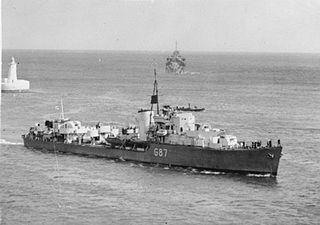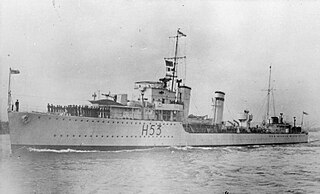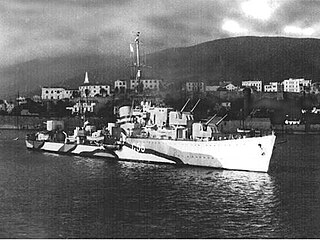
HMS Kingston was a K-class destroyer of the Royal Navy.

HMS Neptune was a Leander-class light cruiser which served with the Royal Navy during World War II. Neptune was the fourth ship of its class and was the ninth Royal Navy vessel to carry the name.

HMS Euryalus was a Dido-class cruiser of the Royal Navy. She was laid down at Chatham Dockyard on 21 October 1937, launched on 6 June 1939, and commissioned 30 June 1941. Euryalus was the last cruiser built at the dockyard.

The Second Battle of Sirte was a naval engagement in the Mediterranean Sea, north of the Gulf of Sidra and south-east of Malta, during the Second World War. The escorting warships of a British convoy to Malta held off a much more powerful squadron of the Regia Marina. The British convoy was composed of four merchant ships, escorted by four light cruisers, one anti-aircraft cruiser and 17 destroyers. The Italian force comprised a battleship, two heavy cruisers, one light cruiser and ten destroyers. Despite the British success at warding off the Italian squadron, the Italian fleet attack delayed the convoy's planned arrival before dawn, which exposed it to intense air attacks that sank all four merchant ships and one of the escorting destroyers in the following days.

Giovanni delle Bande Nere was an Italian light cruiser of the Giussano class, which served in the Regia Marina during World War II. She was named after the eponymous 16th-century condottiero and member of the Medici family. Her keel was laid down in 1928 at Cantieri Navali di Castellammare di Stabia, Castellammare di Stabia; she was launched on 27 April 1930, and her construction was completed in 1931. Unlike her three sisters, the finish and workmanship on the vessel were not rated highly. She was sunk on 1 April 1942 by the British submarine HMS Urge.

HMS Penelope was an Arethusa-class light cruiser of the Royal Navy. She was built by Harland & Wolff ; her keel was laid down on 30 May 1934. She was launched on 15 October 1935, and commissioned 13 November 1936. She was torpedoed and sunk by the German U-boat U-410 near Naples with great loss of life on 18 February 1944. On wartime service with Force K, she was holed so many times by bomb fragments that she acquired the nickname "HMS Pepperpot".

The First Battle of Sirte was fought between forces of the British Mediterranean Fleet and the Regia Marina during the Battle of the Mediterranean in the Second World War. The engagement took place on 17 December 1941, south-east of Malta, in the Gulf of Sirte. It was tactically inconclusive as both forces were limited by the strategic goal of protecting a convoy of their own and as such, neither were looking to force battle.

Force K was the name given to three British Royal Navy groups of ships during the Second World War. The first Force K operated from West Africa in 1939, to intercept commerce raiders. The second Force K was formed in October 1941 at Malta, to operate against convoys sailing from Italy to Libya. Axis air attacks on Malta led to Force K being reduced and on 8 April 1942, the last ship of the force was withdrawn. After a convoy was run to Malta in Operation Stoneage Force K was re-established against Axis convoys.

HMS Argonaut was a Dido-class cruiser of the British Royal Navy which saw active service during the Second World War. Constructed at the Cammell Laird shipyard, Birkenhead, Argonaut was laid down in 1939, launched in September 1941, and formally commissioned into service on 8 August 1942.

HMS Sirius was a Dido-class light cruiser of the Royal Navy. She was built by Portsmouth Dockyard, with the keel being laid down on 6 April 1938. She was launched on 18 September 1940, and commissioned 6 May 1942.

HMS Diamond was a D-class destroyer built for the Royal Navy in the early 1930s. The ship spent the bulk of her career on the China Station. She was briefly assigned to the Mediterranean Fleet in 1939 before she was transferred to West Africa for convoy escort duties. Diamond returned to the Mediterranean Fleet in early 1940 where she generally escorted convoys to and from Malta. The ship participated in the Battle of Cape Spartivento in November. Diamond was sunk by German aircraft on 27 April 1941 whilst evacuating Allied troops from Greece.

Vasilissa Olga was the second and last destroyer of her class built for the Royal Hellenic Navy in Great Britain before the Second World War. She participated in the Greco-Italian War in 1940–1941, escorting convoys and unsuccessfully attacking Italian shipping in the Adriatic Sea. After the German invasion of Greece in April 1941, the ship escorted convoys between Egypt and Greece until she evacuated part of the government to Crete later that month and then to Egypt in May. After the Greek surrender on 1 June, Vasilissa Olga served with British forces for the rest of her career.

HMS Carlisle was a C-class light cruiser of the Royal Navy, named after the English city of Carlisle. She was the name ship of the Carlisle group of the C-class of cruisers. Carlisle was credited with shooting down eleven Axis aircraft during the Second World War and was the top scoring anti-aircraft ship in the Royal Navy.

HMS Nigeria was a Fiji-class light cruiser of the Royal Navy completed early in World War II and served during that conflict. She was named after the British colony of Nigeria.

HMS Defender was a D-class destroyer built for the Royal Navy in the early 1930s. The ship was initially assigned to the Mediterranean Fleet before she was transferred to the China Station in early 1935. She was temporarily deployed in the Red Sea during late 1935 during the Abyssinia Crisis, before returning to her assigned station where she remained until mid-1939. Defender was transferred back to the Mediterranean Fleet just before World War II began in September 1939. She briefly was assigned to West Africa for convoy escort duties in 1940 before returning to the Mediterranean. The ship took part in the Battles of Calabria, Cape Spartivento, and Cape Matapan over the next year without damage. Defender assisted in the evacuations from Greece and Crete in April–May 1941, before she began running supply missions to Tobruk, Libya in June. The ship was badly damaged by a German bomber on one of those missions and had to be scuttled by her consort on 11 July 1941.

HMS Lance was an L-class destroyer of the Royal Navy. She entered service during World War II, and had a short but eventful career, serving in Home waters and the Mediterranean Sea. She was damaged in two consecutive air attacks at Malta in 1942. She was towed back to Britain, declared a constructive total loss and was scrapped. She had been adopted by the civil community of Bexley and Welling, Kent in November 1941.

HMS Dainty was a D-class destroyer built for the Royal Navy in the early 1930s. The ship was initially assigned to the Mediterranean Fleet before she was transferred to the China Station in early 1935. She was temporarily deployed in the Red Sea during late 1935 during the Abyssinia Crisis, before returning to her assigned station where she remained until mid-1939. Dainty was transferred back to the Mediterranean Fleet just before World War II began in September 1939. She briefly was assigned to West Africa for convoy escort duties in 1940 before returning to the Mediterranean. The ship participated in the Battle of Calabria in July 1940 and was assigned to convoy escort and patrol duties until she was sunk by German bombers off Tobruk on 24 February 1941.

HMS Kimberley was a K-class destroyer of the Royal Navy. She served in the Second World War and survived it, being one of only two of the K-class to do so. So far she has been the only ship of the Royal Navy to bear the name Kimberley, after the town of Kimberley, Northern Cape, site of the Siege of Kimberley in the Second Boer War. She was adopted by the civil community of Eastwood, Kimberley and Selston, Nottinghamshire in 1942 after a successful Warship Week campaign for National Savings.

HMS Lively was an L-class destroyer of the Royal Navy. She served during the Second World War, and was sunk in the Mediterranean in an air attack on 11 May 1942.

HMS Lightning was an L-class destroyer of the Royal Navy. She was launched on 22 April 1940 and sunk on 12 March 1943 by German Motor Torpedo Boat S-55.





















